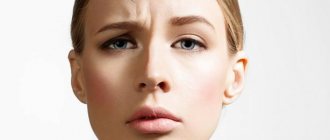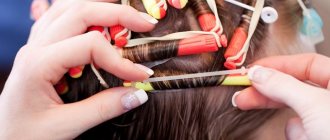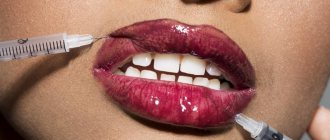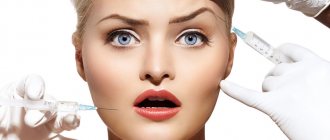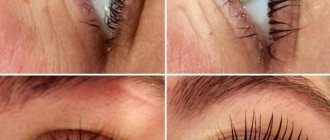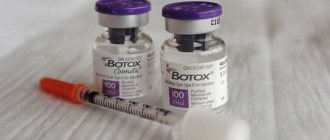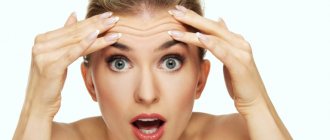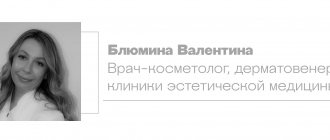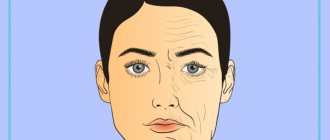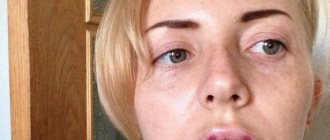More than a third of all botulinum therapy procedures are injections of Botox or similar drugs into the forehead. Injections are carried out in this area more often than in any other area of the face or body, simply because wrinkles form here earlier than anywhere else - the forehead is actively involved in the expression of emotions, the frontalis muscle is constantly involved in the process of raising the eyebrows, and, as a result, already at a relatively young age, horizontal wrinkles form on the skin here.
The effect is further enhanced by the high visibility of these skin folds. If in some other places (for example, in the corners of the eyes) wrinkles are small and are visually smoothed out by eyelashes, eyes and sometimes hair, then the forehead occupies most of the face and any skin defects here literally catch the eye. For this reason, wrinkles on the forehead often require action even earlier than the classic “eyebrow” for Botox.
Here we will immediately agree in the future to talk specifically about Botox injections in the forehead, and not in the upper part of the face in general. Traditionally, many patients consider the glabellar wrinkle to be a frontal defect. This established view is also supported by the simultaneous injection into the forehead and bridge of the nose, which is considered classic - as a rule, if a fold has appeared between the eyebrows, then at this time there is already something to work on on the forehead. As a result, doctors usually need to pierce both the glabellar wrinkle and the entire forehead at the same time.
However, here we will only talk about the forehead, wrinkles on it and Botox injections specifically into the frontal muscles.
By the way, we will discuss not only Botox, but also other botulinum toxin preparations due to their similar action and generally identical procedure for use. Considering that the word “Botox” is more often understood to mean any botulinum toxin preparation, and not just a specific product of the Allergan Corporation, this would be quite justified.
So, when you need to inject Botox into the forehead, what cosmetic effects can be achieved with such procedures, how are they carried out and what consequences can these injections lead to?
The principle of action of Botox in eliminating wrinkles on the forehead
Botox, like any other botulinum toxin preparations, does not directly affect the wrinkles themselves. It does not fill them, as fillers do, and does not stretch or smooth the skin, which is typical for peelings and reinforcing threads. The principle of its action is different: the drug denervates muscles, the contraction of which leads to creasing of the skin and the formation of creases on it. Since the position of these muscles and the places where folds form are constant, wrinkles form in these places on the skin, which are barely noticeable at first, but gradually become deeper and deeper.
The muscles, the active work of which provokes the appearance of wrinkles on the forehead, are deactivated by botulinum toxin preparations.
If the muscles, whose activity leads to skin compression, relax and do not contract for a long time, such folds do not appear and wrinkles gradually either disappear on their own due to the regeneration of skin cells, or are smoothed out with the help of additional cosmetic procedures.
Muscle relaxation is due to the main effect of botulinum toxin: it disrupts the transmission of nerve impulses at neuromuscular synapses - the points of contact between nerve endings and muscle cells. It is here, at the synapses, that the incoming nerve impulse stimulates the release of acetylcholine, which in turn causes the muscle fiber to contract. When botulinum toxin enters the synapse, acetylcholine ceases to be released and the muscle does not contract, regardless of the activity of the neurons innervating it.
What is especially noteworthy in this case is that after an injection of botulinum toxin, the forehead does not wrinkle either during involuntary muscle contractions, or even when a person attempts to do this intentionally. This is associated with some undesirable effects of botulinum therapy, which will be discussed below.
On a note
By the same principle, botulinum toxin, entering the bloodstream during poisoning, leads to death: it disrupts the innervation of vital muscles of the body, for example, the heart muscle or diaphragm. As a result, a person poisoned with botulinum toxin dies either from cardiac arrest or suffocation. The cosmetic use of botulinum toxin is almost completely safe due to the fact that botulinum toxin does not penetrate into the blood and does not act on vital muscles, and due to the fact that it is injected into the frontal muscles in very small quantities that cannot lead to poisoning.
As a result, a person’s forehead simply stops wrinkling after botulinum toxin injections. Whether the already formed wrinkles will disappear after this depends on age, skin characteristics and the depth of the wrinkles themselves.
Injections of botulinum toxin into the forehead relieve muscles from hypertonicity.
Usually, in women who become aware of “stripes on the forehead” at the age of 30-35, after Botox injections, wrinkles disappear without additional procedures in a few weeks due to the natural elasticity of still quite young skin. In older patients, deep, old wrinkles do not smooth out on their own, even though the skin does not wrinkle. After Botox injections, they need to be eliminated with additional procedures - peelings, biorevitalization, lifting of various types.
Review
I decided to get Botox in my forehead for the first time when I was 30 years old. There was nothing, the wrinkles had not yet formed, I did everything to prevent them from appearing. I was afraid then, because everyone scared me that Botox was very dangerous to health, it hurt to inject it, it didn’t last long, and if it somehow didn’t work well, then it couldn’t be neutralized in any way. Well, in general, I understood - if there is so much negativity, it’s definitely worth a try) I don’t regret it. The effect is wonderful - the forehead is smooth, no stripes, no bumps. At the same time, natural facial expressions are preserved, that is, you can even frown. I have enough for a long time - first for 10 months, then for about 7-8. Now I do it once a year, but because of this, after 3-4 months, wrinkles are already visible, although not directly obvious, you can walk with them. Plus there was a long break of about two years while I was giving birth; Botox is harmful for pregnant women. She gets up normally, there was swelling once, but basically no side effects appear. The main thing I was afraid of was that there was no mask effect, it was not at all visible that Botox had been injected into the forehead. I saw women who were injected with fillers - it’s really scary when the forehead hangs down, the bumps stick out right at the temples. In principle, this does not happen with Botox, so for now I’m only for it.
Yulia, Nizhny Novgorod
The effects of Botox are temporary. This is due to the fact that the body recognizes such chemical denervation as a kind of disorder and independently fights it.
As a result, over several months, new synapses are formed on the processes of the nerve cell, in contact with muscle fibers, but free of botulinum toxin. They begin the normal transmission of nerve impulses, leading to the resumption of muscle activity. After this, muscle contraction again begins to lead to creasing of the skin and the appearance of wrinkles.
How effective and for how long do botulinum toxin preparations smooth out forehead wrinkles?
With proper professional injection of Botox into the forehead, the causes of dynamic wrinkles - the deepest and most noticeable ones - can be completely eliminated. As a result, after the procedure on relatively young skin, the folds will completely disappear on their own, and in older people the same effect will be achieved after additional measures.
In the photo below you can evaluate the result of Botox injections in the forehead:
It can be seen that before the procedure, the wrinkles were very pronounced, and after botulinum therapy they disappeared completely.
In addition to eliminating wrinkles, Botox allows you to slightly “raise” the forehead, eliminate asymmetry in the location of the eyebrows, and remove dermatochalasis (skin hanging over the eyelid).
The result of botulinum toxin injection is visible within a day or two after the procedure. This period may vary slightly from person to person depending on their susceptibility and the presence of side effects, but the maximum time for the effect to appear is 5-7 days after the procedure. If after this period there is no result, it is concluded that the patient is immune to botulinum toxin.
It is noteworthy that in people under 40-45 years of age, Botox leads to such effective smoothing of the skin that their forehead literally begins to shine in the light. This, by the way, is also striking and may seem unusual.
The already developed effect lasts up to 6-8 months, after which wrinkles gradually appear again. Statistics show that due to the high mobility and large area of the frontal muscle, its activity is restored somewhat faster than, for example, the activity of individual fibers of the orbicularis oculi muscle. For this reason, in order to permanently maintain the effect, Botox injections into the forehead need to be done regularly.
There is an assumption that the more forehead injections have been performed, the more often subsequent procedures will have to be repeated. Theoretically, this can be justified by the mechanisms of the body’s adaptation to botulinum toxin, but in fact there is no data confirming this hypothesis.
It is also useful to read: Is it possible to inject Botox during menstruation?
By the way, about immunity: according to statistics, in 5-8% of patients the effect of botulinum toxin does not manifest itself at all. This is most often associated with existing immunity - if a person has previously encountered this substance in his life (for example, suffered from botulism) and he has developed mechanisms to neutralize the poison. In such patients, injections of any botulinum toxin preparations - Botox, Dysport, Xeomin and the like - will be equally ineffective.
There is a category of patients for whom botulinum toxin injections do not work, so the result of the procedure will be almost zero.
In any case, Botox can effectively eliminate only dynamic wrinkles. It is either impossible in principle to remove other cosmetic defects with its help, or the effect of the product will be limited.
For example, Botox will not be able to remove age spots, bumps or, conversely, dents, especially those caused by age, associated with thinning of the skin. Proper use of botulinum toxin preparations can, to a certain extent, reduce the visibility of fresh scars and scars, but it will not help completely hide them.
What not to do after: list of prohibitions
Let's figure out what not to do after injections.
- Within 6 hours:
- Touch the injection site.
- Apply makeup or do other facial procedures.
- Take antithrombotic drugs.
- Lie.
- Tilt.
- From 6 hours until the end of the first day:
- Use a directed stream of hot air into your face (do not use a hairdryer).
- Eat spicy, salty and too fatty foods.
- Take flights.
- Touch the injection site.
- Take a hot bath or shower.
- Play sports (you can find out why you should refrain from playing sports after Botox here).
- Visit a cosmetologist for facial procedures.
- Go to the pool or sauna (read about why a sauna immediately after Botox is dangerous in our material).
- Sunbathe.
- Get vaccinated.
- Smoking.
- Drink tea, coffee, and alcoholic beverages (read about whether botulinum toxin injections are compatible with drinking alcoholic beverages here).
- Take antibiotics and some other medications (you can find out whether you can take antibiotics at the same time as Botox injections here).
- Pilling is prohibited.
TIP : If you strictly follow these rules, you can avoid possible unpleasant consequences.
The procedure for injecting Botox drugs under the skin is a very serious step, so you need to prepare and study all the information. Choosing a good clinic and a highly qualified specialist is a priority . It is this person who will be able to fully assess the need for a session, the likely risks and give the necessary effective advice.
Now you know how many days you should not drink strong alcoholic drinks after botulinum toxin injections in the forehead, and also what complications occur when the procedure is performed incorrectly.
Watch a video about what not to do after Botox injections:
Procedure
The botulinum therapy procedure for the forehead muscles is usually carried out quite quickly and takes no more than an hour. In most cases, it is combined with injections into the eyebrow fold, sometimes with botulinum therapy of other areas of the face.
Immediately before the procedure, the doctor conducts a thorough diagnosis, during which he:
- Asks the patient to portray certain emotions (smile, frown, raise an eyebrow sardonically), tense different facial muscles. This will allow not only to assess the depth and degree of “negligence” of wrinkles, but also to detect the individual anatomical features of the patient’s face in order to inject Botox correctly in the future - into the right fibers, to the right depth and in the right quantities;
Before the procedure, the doctor carefully examines the patient’s face in order to subsequently achieve maximum effect.
- Examines anamnesis, assesses the presence or absence of contraindications;
- Issues a special agreement for botulinum therapy for signature, in which the patient confirms in writing that he is aware of the possible risks of side effects of the procedure.
The doctor must also make sure that the patient comes to the procedure properly prepared. Before the procedure, you should not take certain types of medications - muscle relaxants, antidepressants, antispasmodics, tonics, antibiotics. It is highly undesirable to drink alcohol or play sports on the day of the procedure. All this can affect muscle activity, diagnostic accuracy and, ultimately, the outcome of the procedure.
After diagnosis, the doctor selects the injection points and amounts of the product.
When choosing injection points, the cosmetologist must first assess which muscles cause the skin to wrinkle, how the fibers of these muscles are located, and how strongly they contract in the patient. Ideally, the muscle fibers should be denervated in a targeted manner, so as to eliminate wrinkling of the forehead, but preserve the expression of emotions on it.
On a note
Beginners and inexperienced cosmetologists often make injections according to “points” - universal patterns used to obtain one or another result. Obviously, such diagrams can always only be guidelines, since both the forehead itself and the location of the muscle fibers under the skin on it are very individual. Working according to “universal” schemes here is fraught with various complications, since the location of the drug administration points for each person will be specific to one degree or another.
Before administering the product, the doctor restores the solution by adding a solvent to the bottle with the powder. Then the required amount of the drug is taken from the bottle with a syringe with a very thin cosmetic needle and the doctor begins the injections.
The skin at the site of each injection is wiped with an analgesic (lidocaine or its analogue), grabbed with the index finger and thumb at a distance of 1-1.5 cm and slightly compressed. A needle is inserted into the formed roller to the required depth and the doctor squeezes out the required amount of the drug. Then he opens his fingers and lightly massages the skin at the injection site for a few seconds. After this, an injection is carried out at the next point.
To make an injection, the doctor grabs the skin and injects the required amount of the drug into the resulting roller.
In general, the administration of the drug usually lasts 10-15 minutes and is carried out in a seated chair with the back slightly reclined. Upon completion of the injections, the patient remains in the chair for another 10-20 minutes for medical supervision. This is necessary in case of a possible allergic reaction - it is allergies that pose the greatest danger to patients, and when their signs appear, the doctor applies relief agents as quickly as possible. If there is no allergy at this time, the cosmetologist can give the patient recommendations on how to prevent possible side effects.
Is it possible to inject the drug at home?
Some women prefer to take care of their face at home. It is strictly forbidden to inject Botox yourself - the procedure should only be carried out by a certified specialist. At home, it is possible to use non-injection methods to maintain youth.
Homemade cosmetics are prepared using natural ingredients, but are significantly inferior in effectiveness to injection plastic surgery. One of the most popular skin care methods at home is a cream with a Botox effect. It refreshes the face and helps prevent the appearance of the first wrinkles.
You can replace beauty injections with appropriate masks and lotions , which extremely rarely cause negative consequences and allergic reactions.
Places of administration and amount of product used
In most cases, Botox is injected into the forehead at 4-6 points - two at different heights on the sides and two in the center of the forehead. With very strong muscle contractions and deep wrinkles, the number of points can be increased to 12 (they are evenly distributed across the entire width of the forehead), and with weak creases - reduced to 2.
The injection points of the drug should not be below 1 cm from the edge of the orbit. It is advisable that they are 2-3 cm higher - this reduces the risk of developing ptosis after injection.
The doctor chooses the amount of the drug based on the diagnostic results and the specifics of the drug itself. For example, 1 unit of Botox and its analogues is approximately equivalent in severity to 2-3 units of Dysport.
Many doctors recommend not treating lower frontal wrinkles with Botox. Injections near it are fraught with ptosis, and practice shows that the correct use of filler here can effectively smooth it out.
Most often, 8-20 units of Botox are injected into the forehead area in women and up to 30 units in men.
A woman usually needs from 8 to 20 units of Botox in the forehead area (depending on age, skin condition and depth of wrinkles).
Practice shows that the amount of botulinum toxin used has little effect on the duration of the effect. Rather, the amount of product injected affects the amount of forehead area on which the results appear. If the wrinkles are very deep and long, you have to take large quantities of the drug to eliminate them along their entire length. If they are relatively small, it is enough to immobilize the muscles in the central part of these wrinkles, and their corners will then smooth out on their own.
Therefore, if a particular patient is given Botox for the first time, then they try to administer the minimum dose, and, if necessary, additional injections after a few weeks. This is safer than immediately injecting an excessive amount of the drug with the risk of side effects.
Indications for such injections
In cosmetology practice, the presence of noticeable wrinkles between the eyebrows is quite enough to inject Botox into this area. Moreover, injections are also carried out when the “eyebrow” is just forming, when there are no permanent visible stripes on the surface of the skin yet.
In addition, in many cases, botulinum therapy in the glabella area may be indicated in the presence of other, both cosmetic and pathological indications:
- Obvious asymmetry in the location of the eyebrows, when one of them is lower than the other or directed towards the edge of the face at a different angle;
- Asymmetry of facial expressions, noticeable only when expressing certain emotions;
- Blepharospasm, in which a significant part of the facial muscles are constantly tense and contracted. Usually it severely spoils and even disfigures the face itself and causes serious inconvenience for the patient (for example, it does not allow one to open the eye or mouth);
Botulinum toxin injections can help people with blepharospasm.
- Wrinkles in the lower part of the forehead or on the bridge of the nose (so-called “bunny wrinkles”).
In all these cases, Botox may need to be injected not only in the area between the eyebrows, but also in the forehead, brow ridges and around the eyes. The doctor develops the location of the points for drug administration independently, and in an ideal case, individually for each patient.
Details about safety: possible contraindications and side effects
In general, Botox injections into the forehead are considered a fairly safe procedure. The number of various undesirable effects after botulinum therapy, correlated with the number of injections performed in general, is very small, and the complications themselves are usually relatively mild and pass quickly.
There are even cases where former clinic patients inject each other with Botox on their own, as part of a regular “home” cosmetic procedure - just like painting their nails or curling their hair.
However, due to the large number of botulinum therapy procedures performed, in general, side effects occur quite often. Sometimes they develop for objective reasons, in other cases they arise as a result of doctor errors or are a consequence of a violation of the rehabilitation regime on the part of the patient.
Most often, undesirable effects develop due to the tissue reaction to the botulinum toxin drug. These include, for example:
- Swelling and bumps on the forehead at the injection sites usually disappear on the third or fourth day;
Injection marks, swelling and redness usually disappear within a few days.
- Pain and itching at the injection sites disappear quickly, within the first day;
- Sensation of a foreign body, heaviness under the skin of the forehead;
- Headache, respiratory syndrome - usually lasts 2-3 days after injections;
- Rash, pimples (sometimes with suppuration) in the injection area.
All these manifestations are temporary and do not last long. However, many patients who count on a literally instant effect of the product often manage to panic if the next day after the procedure they discover not a smooth forehead, but swelling or unsightly bumps at the injection site. Of course, after 3-4 days all these consequences will disappear and the forehead will become exactly what the woman dreamed of, but during these three days she will probably have time to write several negative reviews on all the forums and websites known to her, and it is based on these reviews that other patients in the future they will form their own opinion about the procedure itself.
To reduce the risk of undesirable consequences, Botox should be injected into the forehead only if there are no contraindications. Such contraindications include:
- The presence of infectious rashes on the forehead;
- Acute stage of any infectious disease (including influenza and other acute respiratory viral infections);
- Pregnancy and breastfeeding;
- Allergy in the acute stage to any allergen or known intolerance to botulinum toxin;
- Skin tendency to keloid scarring;
- Oncological diseases;
- Taking certain medications.
It is also useful to read: Botulinum toxin type A and its use in cosmetology
The consequences of Botox injection into the forehead in the presence of such contraindications are difficult to predict, and in some cases (for example, with intolerance) can be deadly.
Due to the risk of side effects and complications, it is not recommended to inject Botox “for the sake of experiment”, for example, at a very young age (up to 30 years), when even women with very expressive facial expressions and already formed forehead wrinkles are easier and safer to disguise them with cosmetics than inject Botox. On the other hand, it is also undesirable for very elderly people with deep wrinkles to undergo botulinum therapy - this procedure will not help to radically affect their appearance, but it is quite capable of causing unpredictable effects.
It is not recommended for women at a fairly mature age to inject Botox, since it is almost impossible to correct deep age-related changes with such injections.
Rehabilitation
After administering Botox, you should not take a vertical position and physically overexert yourself for 4 hours to prevent the drug from spreading. During this period it is especially unstable. The first 2 weeks are not recommended:
- take a hot shower;
- drinking alcohol;
- use a hair dryer to dry your hair;
- be near a hot stove;
- use decorative cosmetics;
- touch your face with your hands;
- visit the bathhouse and sauna;
- sunbathe;
- engage in any kind of sports;
- take medications, in particular: antibiotics, anticoagulants, antiplatelet agents;
- take vitamins B and E.
It is advisable to sleep on your side or back.
If the prescribed rules are not followed, the toxin can move to other tissues, causing the effect to be less pronounced or intensify, which will provoke a number of complications.
Possible negative consequences of errors on the part of the doctor and the patient
When Botox is injected into the forehead, the most undesirable side effects are those that persist for the entire duration of the drug. It can be:
- Noticeable disturbances in natural facial expressions. The effect of botulinum therapy itself is always a certain change in the complex of facial expressions, but the negative consequences include those that are very noticeable and spoil the appearance. An extreme case of such violations is the so-called “mask on the forehead,” when, due to complete immobilization of the muscles, the skin on the forehead does not move at all under any emotions;
- Facial defects - raising the eyebrows, symmetrical or uneven, and more often, on the contrary, their lowering and the appearance of an expression of fatigue on the face;
- Enlargement and protrusion of the eyebrows - develops due to the fact that the entire function of keeping the eyes open is transferred to the muscle fibers located at the level of the eyebrows. These muscles quickly increase in size, become harder, and a so-called “ridge” is formed, giving the face features of masculinity and aggressiveness;
- Ptosis is drooping of the eyelid with partial or complete closure of the eye.
These consequences occur rarely and are mostly associated with errors and unprofessionalism of the doctor who administers either too large doses of the drug or injects non-target muscles. All of them are due to the main effect of Botox and therefore last approximately as long as the target effect of using this product. Since it is impossible to physically remove Botox from the forehead muscles, when such effects appear, compensatory procedures are carried out to help quickly get rid of both unwanted consequences and, along with them, the result of the action of Botox itself.
The same effects appear when the rehabilitation regime after botulinum therapy is violated. For example, after injections, you cannot take a horizontal position and sleep for several hours, you cannot play sports or drink alcohol, undergo other cosmetic procedures, bathe in hot water or stay in the sun for a long time. Violation of these rules may cause the drug to diffuse into non-target muscles and cause them to become immobilized.
After the botulinum therapy procedure, you should strictly adhere to the doctor’s recommendations.
Review
I decided for myself - Botox only on the forehead and between the eyebrows. Do not touch crow's feet under any circumstances! I have a very unpleasant experience, okay, not mine. They injected my sister: her forehead, between her eyebrows, and the edges of her eyes. So, everything seems to be fine, my head doesn’t hurt, it doesn’t affect my vision, there are no horror stories from other people’s reviews. But only until she smiles. Smiles - that’s it, Atas. The lips spread into a smile, but the eyes and forehead do not move, nothing pulls them on the side or below. It just gives a creepy impression, as if the person is not alive. I didn’t tell my sister, but she apparently saw everything herself. Well, she managed to remove everything quickly; Botox is quickly neutralized by an accelerated metabolism. She is like that herself, plus she is an athlete, with intensive training and preparation for training camps, the effect of Botox wears off in 1-2 months, even for one girl it stopped working in three weeks, she had to be re-injected in the same month. In general, she pushed herself and everything quickly returned to normal. But now I know for sure that it is better to inject Botox only on the forehead and between the eyebrows, and to do this only with a good doctor, so that he can select the dosage very clearly.
Lilia, Moscow
Compared to these effects, the consequences caused by insufficient dosages of Botox seem less critical. Usually in such cases, incomplete removal of wrinkles occurs, and it is enough to simply “finish off” the forehead after a few weeks.
Separately, it should be said about the possible consequences of injections of counterfeit botulinum toxin preparations. They can be very diverse - from relatively harmless (for example, simply no effect) to very dangerous (severe allergies, drug rejection, formation of noticeable scars), and in many cases the doctor may not even suspect that he is injecting a non-original remedy, because He is not responsible for purchasing at the clinic. This is another reason not to chase the low price of the procedure, but to choose a doctor primarily based on reputation and reviews.
A few words about the cost of the procedure
The cost of Botox injections depends, first of all, on the amount of the drug that will be administered during the entire procedure, and secondly, on the prestige of the clinic.
As a rule, the price of injections is calculated per 1 unit. On average in Moscow, the procedure costs 300-350 rubles per unit for Botox and 180-220 rubles for Dysport.
On average, in the capital, 1 unit of Botox costs 300-350 rubles, and Dysport costs 180-220 rubles.
Botulinum therapy with Relatox as a Russian drug is somewhat cheaper than Botox injections (280-310 rubles for the same quantities as for Botox), but it is after its administration that the forehead most often hurts badly, and the injections of this drug themselves are quite painful. Whether these troubles are worth the savings that the drug provides is an open question.
In the regions, the cost of the procedure may be lower - 270-300 rubles for Botox and 150-180 rubles for Dysport.
The total cost of injections into the forehead ranges from 3000-7000 rubles for a procedure with Botox and 2500-4500 rubles for a procedure with Dysport.
In general, Botox is considered the “gold standard” of botulinum therapy. Doctors know it well, most of them have good experience in its use, which ensures high safety of procedures with it. Part of this security comes at a slightly higher price.
Approximately the same safety is characteristic of Dysport and Xeomin - also quite well-known and long-familiar drugs to cosmetologists. Other products, including various new products, often turn out to be cheaper (it is due to this that their manufacturers are trying to win their place in the market), but with this cheapness, patients pay for possible unintended consequences.
Xeomin, like Dysport, is an analogue of Botox.
Alternative Methods
Let us consider further what other drugs based on botulinum are actively used in Russia and how they work:
- Dysport;
- xeomin;
- lantox;
- relatox.
Regardless of the brand, the substance acts the same - it relaxes the muscle, thereby helping to smooth out wrinkles. The only difference is the price and production technology. The situation is different with fillers. It is a mistake to think that Botox and filler are similar techniques and compare which is better. Botox injections differ significantly from fillers in how they work. Fillers are injected under the skin rather than into muscle tissue. The skin becomes smooth and elastic by filling problem areas with the drug (hyaluronic acid, collagen, vitamin cocktail). You can find out which is better to use - Botox or filler here.
Important! To eliminate fine wrinkles, it is better to use filler.
Possible alternatives to Botox for the correction of forehead wrinkles
It is important to remember that in many cases Botox is not the best treatment for cosmetic blemishes on the forehead. And sometimes it won’t help at all, and completely different methods will need to be used to smooth out wrinkles.
For example, if there are contraindications to botulinum therapy for wrinkle removal, you definitely need to choose other ways. At a relatively young age (up to 50 years) this is not particularly difficult - even dynamic wrinkles can be removed or significantly smoothed out with other drugs. Later, these same products will still be needed due to skin aging - the muscle-paralyzing effect alone will not be enough.
As a rule, the main alternative to Botox and its analogues are fillers. Some work as a filler, simply filling in the tissue under the skin's creases and reducing the appearance of wrinkles.
The most popular fillers are those based on hyaluronic acid. With their help, you can reduce the depth of the frontal recesses.
Their advantage is that they do not violate natural facial expressions. Their disadvantages are incomplete elimination of wrinkles and a high risk of extremely unsightly effects. All those terrible photographs of women disfigured by plastic surgeons demonstrate errors in the use of fillers, due to which the face literally swells, being overfilled with neutral fillers.
Other fillers work on a different principle: they stimulate the production of normal components of the dermis and restore its structure. This is how the effect of biorevitalization manifests itself. They alone cannot quickly and completely remove wrinkles, but they can effectively complement the action of Botox in people over 40 years of age whose skin is beginning to age.
If a person’s wrinkles are shallow, you can get rid of them using various peelings, mesothreads, and thermolifting. Nevertheless, these procedures do not have many clear advantages over botulinum therapy: their price is approximately the same (and sometimes higher), and the side effects can be even more unpleasant.
All this means that choosing both the method of eliminating wrinkles and the drug for botulinum therapy (if the choice is made) should be a doctor who can assess the possibilities of cosmetic correction of the forehead and the safety of each specific procedure. It is precisely the kind of cosmetologist whose opinion you can trust that you need to look for, and then trust him and get the desired effect on your forehead, for which all this was organized.
Useful video about Botox injections: indications and contraindications for them, as well as the stages of the procedure
What effect does the drug have?
Most often, patients aged 35 to 55 years apply for injections of the drug. The table shows an approximate division into age groups that are most likely to have certain indications for Botox.
| Age category, years | Before | After |
| From 18 to 27 | Minor horizontal, rarely vertical wrinkles. | Complete elimination of wrinkles. If there are deeper ones, then they become almost invisible. |
| From 27 to 40 | There are visible traces of wrinkles and folds. Shallow horizontal and vertical wrinkles between the eyebrows, which become more expressive when using appropriate facial expressions. | Fine wrinkles are eliminated, leaving light traces of deeper horizontal folds. Vertical eyebrow wrinkles are almost always eliminated without leaving any traces. |
| From 40 to 50 | Most often, longitudinal wrinkles on the forehead are already clearly defined and can be seen even in a relaxed state. | The skin of the forehead is smoothed out, but traces of deep wrinkles are clearly visible. Some wrinkles are not completely eliminated. |
| From 50 to 65 | There are all kinds of wrinkles, some of them are already very deep. There is a dense network of small wrinkles over the entire area of the forehead. | Fine wrinkles are eliminated and deeper ones are smoothed out, but the forehead skin is not completely straightened. |

